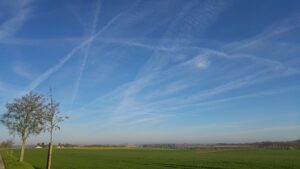An Homage to Earth Day

Climate engineering is nothing new. We’ve been allowing Bill Gates et all to crisscross the skies with chemtrails to block out the sun in order to reduce global warming, or so goes the unproven hypothesis. “Controversial spraying method aims to curb global warming,” CBS News reported in 2018.
Odd, as four years later, “CNBC report on climate research didn’t confirm ‘chemtrails’ theory,” AP reported, contending that “The story reported on a federal plan to research technology such as “stratospheric aerosol injection,” the concept of placing materials in the atmosphere to reflect sunlight away from Earth. Experts say the idea is being investigated and not currently in use.”
Well, look! Up in the skies! It’s a bird! It’s a plane! No, it’s superscientist Bill Gates crisscrossing the skies with chemtrails! “A Bill Gates Venture Aims To Spray Dust Into The Atmosphere To Block The Sun. What Could Go Wrong?” Forbes reported the year before. “Widespread research into the efficacy of solar geoengineering has been stalled for years due to controversy. Opponents believe such science comes with unpredictable risks, including extreme shifts in weather patterns not dissimilar to warming trends we are already witnessing.”
And note the picture we’ve included. Those are neither normal cloud formations nor contrails from planes. Normal contrails don’t criss-cross paths.
So much for the project being stalled and note to self, New Hampshire has become the second U.S. state to potentially outlaw the spraying of aerosolized particulate matter into the skies – a phenomenon commonly referred to as “chemtrails.”
More fun with unproven science: which brings us to the recent torrential rains and flooding in Dubai, which is a desert. Conspiracy theorists have long contended that governments have had the ability to control weather for quite some time now, and as NDTV reported, “Dubai, known for its arid climate and blistering temperatures, was battered by torrential rain… triggering widespread flooding throughout the desert nation. The unforeseen downpour not only halted the bustling city’s usual pace but also sparked worries about the escalating influence of climate change on extreme weather phenomena in the area.” Before you panic, the article did report on “How UAE Creates Artificial Rain, Linked To Dubai Weather Chaos.”
So it seems that we – meaning governments, in this case – can do something about the weather, but is it really such a good idea?
“Meteorologist Warns of ‘Weather Wars’ Between Countries,” said Newsweek. “The Dubai floods act as a stark warning of the unintended consequences we can unleash when we use such technology to alter the weather.”
“As soon as reports like the Newsweek headline began to circulate, matrix media immediately initiated a denial campaign that was a complete reversal of the initial publications on what happened in Dubai and why. The controllers absolutely don’t want the public to comprehend the connection between climate engineering operations and weather catastrophes,” Geoengineering Watch reported.
Or as Forbes said, what could go wrong?
“Ahmed Habib, a specialist meteorologist, had said that the Tuesday rains had stemmed partly from cloud seeding. Habib later told CNBC that six pilots had flown missions as part of regular protocol, but had not seeded any clouds.”
Really?
Basic physics tells us that for every action, there is a reaction and as for controlling/manipulating the weather, how accurate are climatologists/meteorologists when it comes to predicting the weather two or three weeks out – or in many cases, even later that day?
Much less can they predict the long-term effects of the weather/climate manipulations currently being undertaken and the problem with seeding the skies with chemicals is that, in the words of Tom Lehrer, Once the rockets are up, who cares where they come down ? That’s not my department, said Wernher Von Braun. Achieving sustainability is one thing, but when it come to actually interfering with the weather and weather patterns, caution needs to be taken. If what happened in Dubai is any indication, or perhaps it needs to be regarded as a cautionary tale, attention must be paid, or we may well be at the point where we’ve literally opened the floodgates. Onward and forward.